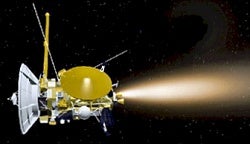Controllers of the Cassini spacecraft, which is now orbiting Saturn, confirmed Monday that a planned 51-minute engine firing had been completed successfully. The craft, now near its greatest distance from Saturn in its first and longest orbit around the planet, will pass 186,000 miles (300,000 kilometers) farther from Saturn at its next closest approach — far enough to avoid another passage through the rings. The successful orbit change also put Cassini on target for its first close encounter with Saturn’s giant moon Titan in late October.
This was Cassini’s third-longest engine burn. The critical firing that inserted the craft into Saturn orbit on June 30 lasted 97 minutes. A “deep space maneuver” in December 1998 was 88 minutes long.
Cassini’s propulsion system uses helium to push propellant and oxidizer into the engine’s combustion chamber. The craft’s helium regulator sprung a leak in 1997, but engineers coped with the problem by using different valves to isolate the system between engine firings. Monday’s maneuver was the last burn requiring pressurization in the spacecraft’s 4-year tour of Saturn.
Cassini’s first Titan flyby on July 2 took the craft within 211,000 miles (340,000 km) of the moon’s cloud tops, but the October 26 encounter will be much closer. “We’ll fly by Titan at an altitude of 746 miles [1,200 km], ‘dipping our toe’ into its atmosphere,” notes Signorelli.
Over the next 4 years, the Cassini orbiter will execute 45 Titan flybys as close as approximately 590 miles (950 km) from the moon. In January 2005, the European-built Huygens probe that is attached to Cassini will descend through Titan’s atmosphere to the surface.










